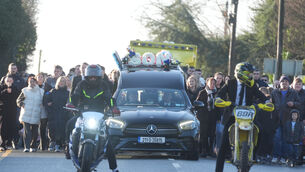Tiny classroom a break for sick kids
IT’S just days to Christmas, but hundreds of children are spending the holiday season in hospital.
The decorations and lifesize Santa adorning the children’s wards at Cork University Hospital (CUH) help to lift the mood for those missing their friends, school concerts or their nativity play.
But teaching and learning is a year-round activity for patients here, whether they stay for just a few days or for weeks.
Dylan Sexton is a regular patient at CUH, but misses his classmates at Dromahane National School near Mallow when he’s in the children’s ward. The 10-year-old had enjoyed a maths trail the day before the Irish Examiner visited, using a metre stick and a trundle wheel to measure different routes around the hospital.
“I like maths and history, so the maths trail was fun,” said Dylan, whose teacher from Scoil CUH visits him in his room.
All the same, he was looking forward to getting home this week and having a few days before Christmas at school in fourth class. “I do miss my friends when I’m staying in hospital. But the classes are a bit shorter here than if I had a full day at school,” Dylan says with a wry smile.
Stephanie O’Regan is in fifth class at St Catherine’s National School, just a few hundred yards from the hospital doors, but had to spend a few days on the children’s ward last week and attended Scoil CUH during her stay.
“I just came in yesterday, I was here before last April. I sprained my ankle and I had a sore tummy and a headache,” said the 11-year-old from Ballincollig.
So what does she think of the school at hospital?
“My school is much bigger, this is like getting a private lesson. It’s kind of different, and I got homework the last time I was here, but it was just maths though,” she said.
While the school must be one of the smallest in the country — barely over six feet wide and no more than 30 feet long — it is also one of the best-stocked. Shelves and shelves of books cover everything from the first reading days of junior infants, right through to higher level Leaving Certificate maths and science.
Principal Gobnait Curran and her deputy Ber Annis have a diversity of teaching backgrounds, from pre-school through to second level, and also have qualifications in special needs education.
“I’ve been working in hospital schools for more than 20 years, I was in St Mary’s Orthopaedic School on the northside until we opened here in 2000,” said Ms Curran
The staff prioritise frequent visitors and long-term patients, with medical staff bringing children to the classroom in turns — when they do not have to have surgery, tests or X-rays.
“A child with appendicitis could be in hospital for a fortnight, but a fortnight missed just once isn’t going to create a significant gap in their schooling. But if you are in here for weeks a few times a year, it might,” explains Ms Curran.
“We have children of all school-going ages, from junior infants to Leaving Certificate, and any mix of them could be in with us at a given time. Or if a child has a condition like cystic fibrosis, which makes them susceptible to other people’s infections, we visit them in their room for a short class,” she said.
“We try to do things they mightn’t normally do at their own school. They usually like coming in here because it means not being in the ward, nobody’s coming at them with needles or doing tests. It’s a place to escape to and they forget for a while that they’re in hospital. Sometimes when their time is up, they might be reluctant to go back to the ward. And it also gives the parents a break from sitting with them in their rooms.”
Eight-year-old Saoirse O’Neill spent a few days in hospital last week and visited Scoil CUH during her short absence from Eglantine National School in Douglas. She had a sore hand and had to go to the operating theatre the day before she was being discharged.
“I thought we were just going to the doctor and then I came here to hospital. It’s just a little bit sore now, I’ve got stitches around my hand,” said Saoirse. But she was getting over her illness and counting down the days to Christmas in the hope that Santa has read her letter asking for a Sylvanian Families hotel.
Six-year-old Kelsi O’Connor from Tower near Blarney is in senior infants at Rathpeacon National School, but she spent a couple of days in hospital last week with a viral infection. Despite her tiredness, she spent half an hour at Scoil CUH playing a computer game that helps her learn about counting and colour co-ordination — an important skill for her ambition to be a hairdresser when she grows up.
Her mum Tina is very pleased with the attention she gets at the school, as Kelsi is unfortunate to have been at the hospital twice already this year.
“It’s great to see they care about her education as well as her health in the hospital. The teachers know from the kids’ own schools what level they’re at and they give all the kids very close attention,” she said.
THE country’s seven hospital schools have some of the most advanced technology in their classrooms to allow young patients improve their learning during their illnesses.
A project run by Trinity College Dublin allows children at each of the schools — at CUH in Cork, the Mid-Western Regional Hospital in Limerick, Dublin’s Temple Street, Crumlin, Tallaght, Beaumont, and Dún Laoghaire hospitals — to link up with each other.
“We have four touch- screen computers and we use a webcam for web- conferencing between the other hospital schools and we sometimes have art and poetry competitions between children in the different hospitals,” said Scoil CUH principal Gobnait Curran.
“If a child is moving to one of the Dublin hospitals, they can see and talk to the teachers and view the classrooms beforehand. We might, for example, have a child who was in a traffic accident being moved to the National Rehabilitation Hospital in Dún Laoghaire, and this makes the transition easier,” she said.
As well as communication among themselves, hospital teachers maintain regular contact with mainstream schools to ensure children are keeping in touch with what their classmates are learning while they are ill.
“For long-term or regular patients, we get their booklist from their own school and keep all the relevant textbooks in a schoolbag here for them. And we contact their teachers to follow closely the chapters or parts of the curriculum they’re missing out on,” Ms Curran explains.
The hospital schools also help to organise home tuition for patients who are not fit to return to school when they leave the ward. Dozens of children sit Junior and Leaving Certificate papers in hospital each year, and arrangements are made with the State Examinations Commission for special exam centres to be set up.
Marie Watson, paediatrics clinical nurse manager at CUH, said summers were much busier in the children’s ward because of sporting injuries up to a few years ago but there’s little seasonal difference now in patient numbers.
“Kids will always have coughs, colds, wheezes and sneezes, and you’ll always have children who’ve been in traffic accidents, slipping on ice, or falling in the playground,” she said.
“A lot of the staff are doing 12 and 13-hour days here but they will sometimes help with the children’s homework.
“One of the long-term patients did very well in a homework assignment recently and he was so proud of his accomplishment.
“All the children have huge pride in their school work that they give their teacher,” she said.












